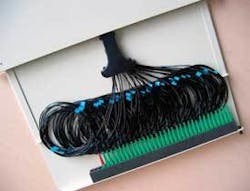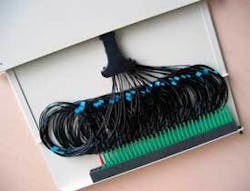Carriers weigh upgrade strategies for FTTH networks
by Johnny Hill
The seeds of fiber to the home (FTTH) were planted decades ago. As carriers foresaw the potential for fiber as the ultimate carrier medium, they established the roots of the optical distribution network, usually running feeder fiber from the central office (CO) into the field to support residential and business DSL.Now that the roots of fiber have taken hold, however, service providers are feeling the pressure to upgrade. New multimedia services such as HDTV and IPTV are expanding the digital menu; each of these, along with existing high-demand applications like network gaming and video-on-demand (VoD), are expected to eat up increasing amounts of bandwidth over time. The rule of thumb used to be that bandwidth demand doubled every 18 months; that metric will only shrink as next-generation services continue to proliferate.
As subscribers continue to sign on for new services, and as their appetite for bandwidth grows unabated, fiber will continue to march deeper and deeper into the outside plant (OSP) network. The question most carriers face is when to take the next step in both FTTH technology and infrastructure. Fortunately, a number of alternatives exist that allow carriers to take an incremental approach tailored to their competitive, financial, physical, and/or market requirements.
Carriers large and small have committed to deploy FTTH in their networks. Verizon has selected a PON as its platform, and AT&T is using PON in greenfield applications with speculation increasing that it will shift from its current “fiber-to-the-node” version of fiber to the curb (FTTC) toward a more FTTH-rich philosophy for overbuilds. Qwest is also looking at PON FTTH, while multitudes of independent telcos, CLECs, and municipalities are already deploying FTTH using both PON and active technologies.
Until recently, PON was touted as the more attractive FTTH approach due to its lower price, while active proponents favored that technology’s performance potential. However, as research continues and the price of active gear continues to come down, the cost/performance ratio has begun to align between the two architectures. The debate over which is best has intensified as a result.
Obviously, with its higher throughput speeds, active is the better theoretical choice. With the fast adoption of HDTV, many customers will soon need 10 Mbits/sec to support their complement of high-definition receivers-and with its 100-Mbit/sec (assuming sufficient backhaul exists from the remote terminal) bandwidth, an active architecture will easily support these services as well as voice and data.
Where greenfield situations exist, it makes sense to place as many feeder fibers into the ground as the number of homes a carrier can possibly support. Even if the carrier employs a splitter-based PON architecture in the near term, it will be protected for the future should active home runs be desired.
Upgrading at the active gear level simply requires replacing CO equipment with more transmit power, or adding more transmit equipment to support additional wavelength transmission via dense or coarse WDM. If the active fiber is fed to an active cabinet in the field, the signal can be regenerated or amplified at that point and then distributed to the desired complement of homes to provide the capacity needed.
Considering its futureproof advantages, combined with its declining cost per user, active fiber is probably the ideal overall choice. Yet PONs represent a perfectly solid alternative that will meet most customer expectations and requirements. PONs not only make the most of existing feeder fiber, but maintenance costs in the field are lower since passive remote terminals do not require power, heating, or cooling.
It’s also important to note that with triple-play video/voice/data over IP, for example, PONs can exist without splitters. In this architecture, active gear is used in the CO but everything else to the home is passive and home-run.
Assuming a 2.4-Gbit/sec optical line terminal (OLT) port in the CO and a 1×32 split ratio at the pedestal or fiber distribution hub in the field, PON delivers 75-Mbit/sec service to the home. With 1×16, the bandwidth doubles to 150 Mbits/sec-more than enough for current needs.
The critical question for PONs, however, is how to plan for the future. The FTTH Council (www.ftthcouncil.org) cites research showing that average home bandwidth demand will reach 100 Mbits/sec within five years, and 1 Gbit/sec or more by 2020. What kind of migration strategy can carriers adopt that will leave that kind of headroom?
One alternative is a hybrid GPON (HGPON). HGPON uses the 2.4-Gbit/sec PON protocol but segments the downstream path by transmitting signals on multiple wavelengths, thereby enabling fewer subscribers to share the bandwidth. As an example, eight separate wavelengths could be sent from the OLT, with each wavelength split to four separate homes. This would deliver 625 Mbits/sec (downstream) per subscriber. Moreover, HGPONs can use the same optical network terminal (ONT) at the home that traditional PONs do-no residential equipment upgrades are needed.
While HGPON is cost-prohibitive today, the rising demand for bandwidth, along with lower future capital costs, will make it viable in the future. HGPON significantly increases capacity without the large expense of running point-to-point feeder fiber. The investment in laser transmission equipment at the CO, while significant, is less than what would be required in the OSP.
Still, considering where the demand is headed, HGPON is seen by many as a transitional strategy. In 2005, Verizon announced plans to migrate to a GPON and eventually directly to a WDM-PON-the standard whereby each individual customer receives a discreet wavelength. WDM-PON is bit-rate and protocol independent, enabling connection to a wide variety of services such as 100Base-T, Gigabit Ethernet, Fibre Channel, SONET, ATM, and ESCON, to name just a few.
At this time, WDM is the most expensive of all upgrade paths. One laser is required for each subscriber; what’s more, it also requires array waveguide grating (AWG) ONTs that use planar lightwave circuitry to discriminate among the multiple wavelengths being transmitted. AWG circuitry must also be cooled, making AWG ONTs significantly more expensive to deploy than passive network units.
Currently, estimates place the present cost of DWDM as high as $3,000 to $5,000 per home, compared to $100 for a conventional PON deployment. However, recent developments are promising a future ability to lower costs using Fabry-Perot lasers that will lock to a specific wavelength. Also, athermal AWG chips are in the offing that do not require cooling.
It’s not clear whether other major carriers will follow Verizon on its quest for WDM-PON. Some say it will be years before WDM-PONs will meet the price points needed to gain acceptance in North America. So do we interpret this to be ten years or two years? Meanwhile, Korea Telecom has already deployed WDM-PON to more than 50,000 homes.
WDM technology may reach affordability much more quickly than anyone predicts. Also, though WDM-PONs are more expensive than pushing more fiber into the field, established neighborhoods usually do not take kindly to their yards being ripped up to install home-run fiber, nor do they generally care for unsightly aerial distribution methods.
Whichever path-passive versus active, aggregated versus home-run, PON versus HGPON versus WDM-PON-a carrier uses for its migration strategy, consideration needs to be paid to the durability and flexibility of network equipment, specifically OSP cabling and cabinetry. Ruggedized components are quickly becoming the preferred standard over Telcordia-rated alternatives, since a $12 patch cord, not rated for the environmental and handling extremes of the OSP, can bring down a huge network segment.
OSP-rated riser materials are typically tested not in the field but in a lab. Harsh real-world environments make working with these materials difficult. The result is that shortcuts and compromises are made during installation, service turn-up, and maintenance, leading to long-term reliability issues.
Inside-rated cable, for example, is designed to withstand temperatures of -4° to +149°F, but it cannot meet the accepted OSP ratings standard of -40° to +185°F. Extreme high and low temperatures, as well as repeated thermal cycling, can possibly cause intermittent power loss. This scenario is often difficult to troubleshoot and causes a lot of frustration.
Pedestals, hubs, and ONTs are also subjected to a huge array of environmental challenges including lightning, pollution, rain, high winds, snow, salt air, and more. Summertime temperatures inside a cabinet can reach +180°F in some parts of the U.S., while humidity, condensation, corrosion, sand, and dust can wreak havoc on connectors and hardware.
To reduce risk of damage caused by handling or blunt force, ruggedized cabling that meets U.S. Department of Defense (DoD) military performance standards is the best choice. The DoD’s Military Performance (MIL-PRF) 85045 specification strictly defines the characteristics that allow fiber-optic cable to operate properly under a huge range of environmental and deployment conditions. The specification covers low-temperature flexibility, crushing, barometric pressure, tensile loading, flammability, fungus resistance, fluid immersion, attenuation rate, and many other factors. Ruggedized cable, properly terminated to all connectors, can withstand the many challenges present in the OSP.
Although environmental factors are a major part of the practical hurdles, the number one cause of fiber-optic network downtime is equipment damage resulting from human error, either through rough handling or improper cable routing. Even the best-designed fiber network equipment can be easily compromised by routing and handling fiber circuits incorrectly, making a well-designed, easy-to-use fiber management system essential for success.
The highest-quality fiber management systems found in OSP cabinets and hubs are designed to reduce both handling and installation time. Cassettes, splitter modules, and slack storage systems will be well thought out and easy to use; they will also support multiple deployment configurations to meet current and future residential needs.
Obviously carriers have a lot to think about they plan their FTTH network upgrades. At the present time, most markets are just beginning to see the deployment of 2.4-Gbit/sec PONs-and we’re already talking about transitions to HGPON and WDM-PON.
The key is to stay informed, as technology shifts in this ever-evolving, lightning-fast industry take place daily. With the proper information in hand, each carrier can make its upgrade decisions based on its individual expertise, cost, and ROI goals, as well as the most important criterion of all-its customer performance expectations.Johnny Hill is a founding member of APA Cables & Networks (www.apacn.com). Hill brings extensive application engineering expertise to his role, with particular experience with harsh environmental conditions associated with the outside plant. He attended the University of Minnesota in Minneapolis and Macalester College of St. Paul, MN.

